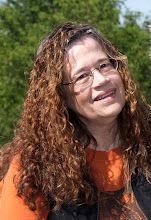 Today's guest is Sean Chercover. Chercover, a former real-life Private Eye, chose Chicago as the setting for his first novel, Big City Bad Blood (HarperCollins, 2007). The Chicago Sun Times described the book as "Sean Chercover's love letter to Chicago. . .a multilayered tapestry," and noted: "Chicago comes alive in this book." I have this one in my "to read" stack. I'm looking forward to it!
Today's guest is Sean Chercover. Chercover, a former real-life Private Eye, chose Chicago as the setting for his first novel, Big City Bad Blood (HarperCollins, 2007). The Chicago Sun Times described the book as "Sean Chercover's love letter to Chicago. . .a multilayered tapestry," and noted: "Chicago comes alive in this book." I have this one in my "to read" stack. I'm looking forward to it! Chercover's second book, Trigger City (HarperCollins, 2008) also takes place in the Windy City. Both books star a Chicago detective named Ray Dudgeon.
Chercover's second book, Trigger City (HarperCollins, 2008) also takes place in the Windy City. Both books star a Chicago detective named Ray Dudgeon.Trigger City comes out in paperback TODAY!
 Read more about Sean and his books at his website.
Read more about Sean and his books at his website.*********
Q: When did you first realize that you wanted to write for publication?
Sean: I was in the 5th grade when I first had the idea that I might grow up to write fiction. But it took me a long time to get up the gumption to try it seriously, and I was 40 when my first novel hit the stores.
Q: Describe one of your earliest works. Who or what inspired you to write it?
Sean: The first work of fiction that I showed to anyone was a short story I wrote in the 5th grade. The assignment was to write "What I Did On Summer Vacation" but I took it as an opportunity to write fiction. So I wrote a story of two inmates at a summer camp that was run like a prison. The inmates were my best friend Greg, and me. We staged a daring escape, and at the end I was shot in the back by one of the guards. The last line was "And then, I died." The teacher told me that you can't write a story narrated by a dead person. She was wrong. You can.
Q: Can you name someone whose encouragement made a significant difference as you developed into a writer?
Sean: Three college professors were very encouraging: Franklin Ashley at the University of South Carolina, and both Fred Guardaphe and Paul Carter Harrison at Columbia College Chicago.
Q: In addition to writing books about Chicago, what other ties do you have to the city?
Sean: I first moved to Chicago in 1987, to attend Columbia College. Later, I worked in Chicago as a private detective. I absolutely love Chicago. It's a great city to live in, and a great city to write about.
 Q: How does your previous occupation as a private investigator help or hinder you in your writing?
Q: How does your previous occupation as a private investigator help or hinder you in your writing?Sean: It helped enormously to have the experience first hand. I learned a hell of a lot, and it provided me with the knowledge to get all sorts of authentic details into my work that most PI fiction gets wrong. The downside is, I often have the urge to strive too hard for realism. Ultimately, the needs of the narrative come first, and you shouldn't let the desire for authenticity to get in the way of that. So that's something I keep an eye out for. But the experience helps more than it hinders. Way more.
Q: What was easy about writing Big City Bad Blood? What was difficult?
Sean: The section of the book that takes place in Hollywood wrote very easily and quickly, and action sequences are always fun to write. The most difficult thing was just getting the critical voices inside my head to shut the hell up.
Q: Of the scenes you wrote for Big City Bad Blood, what is one of your favorites?
Sean: The "swimming pool" scene is the one that readers most often mention, and it was a blast to write. One of my other favorites is the "underground garage" scene, and the police interrogation that follows.
Q: Of the characters mentioned in Big City Bad Blood, choose one you would like to meet and tell us why.
Sean: Of course I hope you'll meet my protagonist, Ray Dudgeon, but that's too easy an answer. I'll go with Gravedigger Peace. Gravedigger is a former mercenary who now works as head groundskeeper in a Chicago cemetery. He's a violent man with a violent past, who now strives for peace. After Big City Bad Blood, I wrote a short story about Gravedigger, which was nominated for an Edgar Award. And he returns in Trigger City.
Q: What would you like us to know right now about your second book, Trigger City?
Sean: Right now, I'd like you to know that Trigger City comes out in paperback on August 25th. I'm happy to report that it won the Dilys and Crimespree awards, and it is nominated for the Anthony, Barry, and Macavity awards.
Q: Anything else you'd like to share?
Sean: Just my thanks to everyone who has read my books and helped to spread the word to others. Word-of-mouth has brought me many new readers, and I appreciate it more than I can say.
________________













